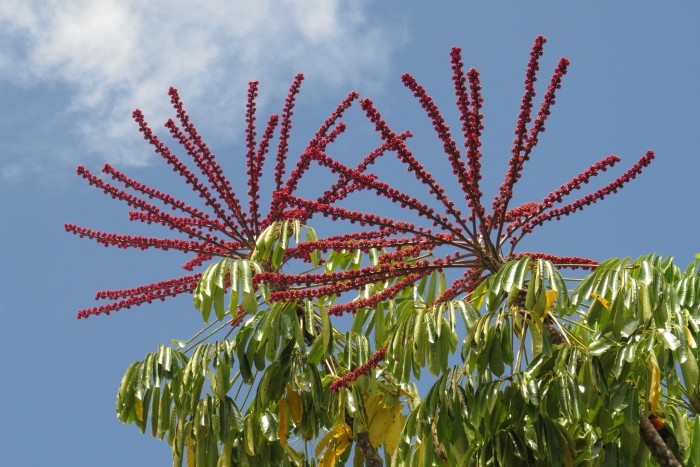Octopus Tree
(Schefflera actinophylla)
Octopus Tree (Schefflera actinophylla)
/
/

© coenobita
CC BY 4.0
Image By:
© coenobita
Recorded By:
Copyright:
CC BY 4.0
Copyright Notice:
Photo by: © coenobita | License Type: CC BY 4.0 | License URL: http://creativecommons.org/licenses/by/4.0/ | Uploader: coenobita | Publisher: iNaturalist |



















































Estimated Native Range
Summary
Schefflera actinophylla, commonly known as Octopus Tree, is an evergreen tree native to the rainforests of Northern Australia and New Guinea. It can grow up to 15 meters (49 feet) tall and is often multi-trunked. The Octopus Tree is notable for its umbrella-like leaf clusters and long, showy red flower spikes that can reach up to 2 meters (6.5 feet) in length. These flowers are particularly striking, blooming in early summer and continuing for several months, and are known to attract nectar-feeding birds which act as pollinators. The plant’s appearance is further enhanced by its large, glossy green leaves that can add a tropical feel to any landscape.
The Octopus Tree is valued for its ornamental qualities, including its impressive flower displays and its ability to provide a lush, tropical ambiance. It is often used in large gardens, parks, and as a houseplant in temperate regions, where juvenile specimens can be maintained with a minimum temperature of 13 °C (55 °F). The plant has received the Royal Horticultural Society’s Award of Garden Merit, reflecting its desirability for cultivation. It prefers well-drained soil and requires only occasional watering and feeding to thrive. However, it is known for its aggressive root system, which can dominate surrounding soil, and it is potentially invasive outside its native range. In cultivation, it generally does best in full sun or part shade, with medium amounts of water, and in soils with medium drainage. Propagation is typically achieved through seed or cuttings.CC BY-SA 4.0
The Octopus Tree is valued for its ornamental qualities, including its impressive flower displays and its ability to provide a lush, tropical ambiance. It is often used in large gardens, parks, and as a houseplant in temperate regions, where juvenile specimens can be maintained with a minimum temperature of 13 °C (55 °F). The plant has received the Royal Horticultural Society’s Award of Garden Merit, reflecting its desirability for cultivation. It prefers well-drained soil and requires only occasional watering and feeding to thrive. However, it is known for its aggressive root system, which can dominate surrounding soil, and it is potentially invasive outside its native range. In cultivation, it generally does best in full sun or part shade, with medium amounts of water, and in soils with medium drainage. Propagation is typically achieved through seed or cuttings.CC BY-SA 4.0
Plant Description
- Plant Type: Tree
- Height: 40-50 feet
- Width: 15-20 feet
- Growth Rate: Moderate
- Flower Color: Red
- Flowering Season: Summer
- Leaf Retention: Evergreen
Growth Requirements
- Sun: Full Sun, Part Shade
- Water: Medium
- Drainage: Medium
Common Uses
Bee Garden, Bird Garden, Potted Plant, Showy Flowers
Natural Habitat
Rainforests of Northern Australia and New Guinea
Other Names
Common Names: Australian Umbrella Tree, Queensland Umbrella Tree, Australian Ivy Palm, Australian Cabbage-Tree, Octopus-Tree, Umbrella-Tree, Umbrella Tree, Australiese Kiepersol, Queensland-Strahlenaralie, Arbre Ombrelle
Scientific Names: , Schefflera actinophylla, Brassaia actinophylla, Heptapleurum actinophyllum, Aralia longipes, Brassaia singaporensis,
GBIF Accepted Name: Schefflera actinophylla (Endl.) Harms